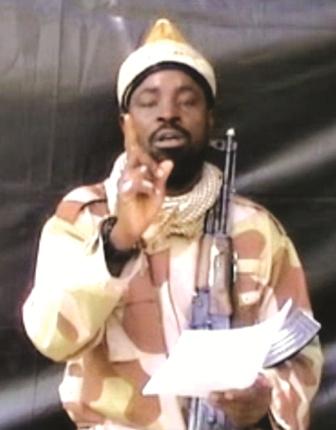The heavy mixture of tragedy and farce surrounding Boko Haram extremists and their bloody behavior in northeast Nigeria continued this week, starting with a photo out of Cameroon.
Authorities there triumphantly released the image of a dead man they said was Abubakar Shekau – Boko Haram’s elusive and shadowy leader. Boko Haram often crosses the border into Cameroon and recently abducted the wife of the nation’s deputy prime minister.
But before ordinary Nigerians or anyone else could make sense of that news, the story suddenly swiveled: The man in the photo wasn’t Mr. Shekau at all, announced Nigerian military officials Wednesday. He was actually one of Shekau’s body doubles – a different Boko Haram commander named Mohammed Bashir.
And the real Shekau? He was already dead, said Nigerian officials, as they have said officially for some years.
If all those plot twists are difficult to follow, it is because Boko Haram has been playing a canny cat-and-mouse game with Nigerian authorities, whose claims to have killed Shekau have never been verified and often come under question.
Whether Shekau is alive or dead does not mean that Boko Haram is not using what may be a rotating cast of “Shekaus” in its public videos, which also makes it difficult for Boko Haram to verify their claim that Shekau lives.
“It’s possible that he was killed as early as 2009 … or he may have survived and just uses doubles to make it more difficult to catch him,” argues Jacob Zenn, an Africa analyst with the Jamestown Foundation who works on Boko Haram. “The latest incident just reveals that the [Nigerian] Security Forces are struggling to grasp the inner workings of Boko Haram, let alone its overall strategy.”
A figure claiming to be “Abubakar Shekau” has long been featured in video messages sent by the group, which has declared northeast Nigeria an Islamic caliphate. Most Shekau videos are rambling and inchoate statements or boasts, or claims of responsibility for recent acts of terror, or taunts at Nigerian authorities or the West, or, more recently, a threat of harm after the abduction of nearly 300 schoolgirls.
Some experts think the videos feature a cast of Shekau doppelgangers.
Whether or not he is actually still alive – former US Ambassador to Nigeria John Campbell thinks he may be – the Shekau persona is a potent weapon for Boko Haram.
“I abducted the girls at a Western education school,” announced a man claiming to be Shekau in a video released by Boko Haram in May, shortly after the girls were taken from the town of Chibok. Flanked by masked militants, the man read from a notebook, a machine gun slung across his chest.
“You are disturbed,” he said. “I will sell them in the market, by Allah. There is a market for selling humans. Allah says I should sell; he commands me to sell. I will sell women. I sell women.
This week, just as Nigeria identified the man in the photo as Mr. Bashir, authorities said 135 Boko Haram militants had surrendered in two northern Nigerian towns, bringing the total to nearly 300 who have put down their weapons in the last three weeks.
Meanwhile, at the UN in New York, Nigerian President Goodluck Jonathan said the country would spare no resource to stop Boko Haram – even as authorities back home backtracked from claims that they were close to a negotiated swap of Boko Haram prisoners with the Chibok schoolgirls.
President Jonathan told the General Assembly that the “threat of terrorism in a few states in the northeastern part of our country has proven to be a challenge to national stability.
On the morning of Jonathan’s speech, former Secretary of State Hillary Clinton and Australia’s former prime minister, Julie Gillard, announced a $600 million initiative to sponsor the education of 14 million girls in the developing world – including a quarter million in Nigeria – in the next five years.

